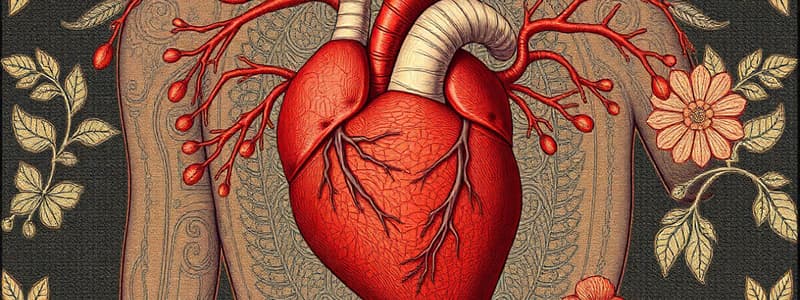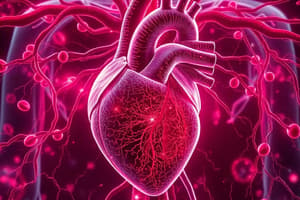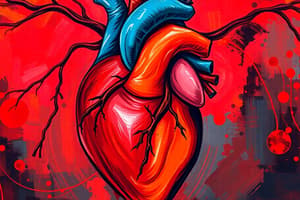Podcast
Questions and Answers
What is a complication that can occur due to an IV line?
What is a complication that can occur due to an IV line?
- Pulmonary Embolus
- Embolus
- Thrombus
- Phlebitis (correct)
Which of the following is a precaution for individuals with a pacemaker?
Which of the following is a precaution for individuals with a pacemaker?
- Use a cell phone (correct)
- Use power tools
- Use an electric blanket
- Use a microwave
What is the purpose of a pacemaker?
What is the purpose of a pacemaker?
- To treat infections
- To regulate blood flow
- To prevent blood clots
- To regulate heart rhythm (correct)
Which of the following assessments should be conducted for a resident with an IV line?
Which of the following assessments should be conducted for a resident with an IV line?
What is the difference between an embolus and a pulmonary embolus?
What is the difference between an embolus and a pulmonary embolus?
What is one function of the circulatory system?
What is one function of the circulatory system?
Which cells in the blood are primarily responsible for defending the body against infection?
Which cells in the blood are primarily responsible for defending the body against infection?
What component of blood makes up 90% of its volume?
What component of blood makes up 90% of its volume?
Which type of blood vessel is responsible for carrying blood away from the heart?
Which type of blood vessel is responsible for carrying blood away from the heart?
What is the largest artery in the circulatory system?
What is the largest artery in the circulatory system?
What happens to arteries as a person ages?
What happens to arteries as a person ages?
What function does hemoglobin serve in red blood cells?
What function does hemoglobin serve in red blood cells?
Which part of the heart is responsible for pumping blood throughout the body?
Which part of the heart is responsible for pumping blood throughout the body?
What is the minimum systolic blood pressure reading that indicates hypertension?
What is the minimum systolic blood pressure reading that indicates hypertension?
Which of the following is NOT a common symptom of hypertension?
Which of the following is NOT a common symptom of hypertension?
What complication is MOST commonly associated with untreated hypertension?
What complication is MOST commonly associated with untreated hypertension?
Which of the following treatments is aimed specifically at lowering blood pressure?
Which of the following treatments is aimed specifically at lowering blood pressure?
Among the listed causes, which condition is particularly linked to narrowing blood vessels?
Among the listed causes, which condition is particularly linked to narrowing blood vessels?
What is a potential sign of severe hypertension, as exemplified by Mr. Dean's symptoms?
What is a potential sign of severe hypertension, as exemplified by Mr. Dean's symptoms?
Which lifestyle change can help in the management of hypertension?
Which lifestyle change can help in the management of hypertension?
What condition related to pregnancy can contribute to hypertension?
What condition related to pregnancy can contribute to hypertension?
What is the immediate action you should take upon finding Mrs. Cooper unconscious on the floor?
What is the immediate action you should take upon finding Mrs. Cooper unconscious on the floor?
Which is a primary characteristic of postural hypotension?
Which is a primary characteristic of postural hypotension?
What indicates that Mrs. Cooper is experiencing more than just momentary dizziness?
What indicates that Mrs. Cooper is experiencing more than just momentary dizziness?
Which of the following factors is NOT commonly associated with an increased risk of Coronary Artery Disease (CAD)?
Which of the following factors is NOT commonly associated with an increased risk of Coronary Artery Disease (CAD)?
What is a common misconception about heart disease as reflected in M.J.'s views?
What is a common misconception about heart disease as reflected in M.J.'s views?
Which lifestyle change is essential for someone at high risk of CAD?
Which lifestyle change is essential for someone at high risk of CAD?
What does atherosclerosis lead to in patients with CAD?
What does atherosclerosis lead to in patients with CAD?
What aspect of patient education should be emphasized for M.J. concerning her health risks?
What aspect of patient education should be emphasized for M.J. concerning her health risks?
What is the systolic pressure threshold that defines hypotension?
What is the systolic pressure threshold that defines hypotension?
Which of the following symptoms is NOT commonly associated with hypotension?
Which of the following symptoms is NOT commonly associated with hypotension?
What strategies can help manage symptoms of hypotension?
What strategies can help manage symptoms of hypotension?
Which factor can cause sudden drops in blood pressure leading to hypotension?
Which factor can cause sudden drops in blood pressure leading to hypotension?
Which of the following is considered a complication of hypotension?
Which of the following is considered a complication of hypotension?
What is a common dietary recommendation for someone with hypotension?
What is a common dietary recommendation for someone with hypotension?
Which of the following describes postural hypotension?
Which of the following describes postural hypotension?
What is NOT recommended for individuals managing hypotension?
What is NOT recommended for individuals managing hypotension?
What is the primary cause of angina pectoris?
What is the primary cause of angina pectoris?
Which of the following is a common trigger for angina pectoris?
Which of the following is a common trigger for angina pectoris?
What is the typical duration for symptom relief of angina with rest?
What is the typical duration for symptom relief of angina with rest?
Which treatment is commonly administered for angina pectoris?
Which treatment is commonly administered for angina pectoris?
Myocardial infarction is primarily caused by what?
Myocardial infarction is primarily caused by what?
Which of the following can be a sign of myocardial infarction?
Which of the following can be a sign of myocardial infarction?
What immediate action should be taken if a patient with angina does not experience pain relief after the maximum dose of nitroglycerin?
What immediate action should be taken if a patient with angina does not experience pain relief after the maximum dose of nitroglycerin?
What lifestyle change is often recommended after a myocardial infarction?
What lifestyle change is often recommended after a myocardial infarction?
Flashcards
Functions of Circulatory System
Functions of Circulatory System
Carries nutrients, removes waste, regulates temperature, and defends against disease.
Components of Circulatory System
Components of Circulatory System
The system consists of blood, heart, and blood vessels.
Red Blood Cells (RBCs)
Red Blood Cells (RBCs)
Also known as erythrocytes, they carry oxygen and give blood its red color due to hemoglobin.
White Blood Cells (WBCs)
White Blood Cells (WBCs)
Signup and view all the flashcards
Platelets
Platelets
Signup and view all the flashcards
Arteries
Arteries
Signup and view all the flashcards
Veins
Veins
Signup and view all the flashcards
Capillaries
Capillaries
Signup and view all the flashcards
Hypertension
Hypertension
Signup and view all the flashcards
Hypotension
Hypotension
Signup and view all the flashcards
Postural Hypotension
Postural Hypotension
Signup and view all the flashcards
Signs of Hypotension
Signs of Hypotension
Signup and view all the flashcards
Causes of Hypotension
Causes of Hypotension
Signup and view all the flashcards
Complications of Hypotension
Complications of Hypotension
Signup and view all the flashcards
Diet for Hypotension
Diet for Hypotension
Signup and view all the flashcards
Management of Hypotension
Management of Hypotension
Signup and view all the flashcards
Pacemaker Purpose
Pacemaker Purpose
Signup and view all the flashcards
Phlebitis
Phlebitis
Signup and view all the flashcards
Thrombus
Thrombus
Signup and view all the flashcards
Embolus
Embolus
Signup and view all the flashcards
Precautions with Pacemakers
Precautions with Pacemakers
Signup and view all the flashcards
Cardiovascular System
Cardiovascular System
Signup and view all the flashcards
Cardiovascular Disorders
Cardiovascular Disorders
Signup and view all the flashcards
Treatment for Hypertension
Treatment for Hypertension
Signup and view all the flashcards
Critical Thinking in Hypertension
Critical Thinking in Hypertension
Signup and view all the flashcards
Angina Pectoris
Angina Pectoris
Signup and view all the flashcards
Common triggers of Angina
Common triggers of Angina
Signup and view all the flashcards
Symptoms of Angina Pectoris
Symptoms of Angina Pectoris
Signup and view all the flashcards
Rest and Angina
Rest and Angina
Signup and view all the flashcards
Treatment for Angina
Treatment for Angina
Signup and view all the flashcards
Myocardial Infarction (MI)
Myocardial Infarction (MI)
Signup and view all the flashcards
Causes of MI
Causes of MI
Signup and view all the flashcards
Post-MI Care
Post-MI Care
Signup and view all the flashcards
Signs of Mrs. Cooper's Condition
Signs of Mrs. Cooper's Condition
Signup and view all the flashcards
Coronary Artery Disease (CAD)
Coronary Artery Disease (CAD)
Signup and view all the flashcards
Risk Factors for CAD
Risk Factors for CAD
Signup and view all the flashcards
Age and CAD
Age and CAD
Signup and view all the flashcards
Patient Education for CAD
Patient Education for CAD
Signup and view all the flashcards
M.J.’s Risk Factors
M.J.’s Risk Factors
Signup and view all the flashcards
Pathophysiology of CAD
Pathophysiology of CAD
Signup and view all the flashcards
Study Notes
Cardiovascular System
- The circulatory system's functions include carrying nutrients, oxygen, and other substances to cells, stopping bleeding, promoting healing, meeting increased exercise demands with increased blood flow, removing waste products, and regulating body temperature.
- It defends the body from microbes that cause disease.
- The circulatory system consists of the blood, heart, and blood vessels.
The Blood
- Blood consists of blood cells and plasma, primarily water.
- Red blood cells (RBCs), also called erythrocytes, give blood its red color due to hemoglobin.
- White blood cells (WBCs), also called leukocytes, protect the body from infection.
- Platelets (thrombocytes) are necessary for blood clotting.
The Heart
- The heart pumps blood through blood vessels to tissues and cells.
- It lies within the middle to lower part of the chest cavity, towards the left side.
Blood Vessels
- Arteries carry blood away from the heart. The aorta is the largest artery. Arterioles are the smallest branches of arteries.
- Capillaries are tiny blood vessels that pick up waste products from cells.
- Veins return blood to the heart. The inferior and superior vena cava are the two main veins.
Blood Flow Through the Heart
- A visual representation of the flow of blood through the heart in two minutes is shown.
Critical Thinking Questions
- Name three functions of the heart. The heart pumps blood throughout the body, regulates blood pressure, and helps maintain homeostasis.
- What is RBC and its function? RBC (red blood cell) transports oxygen to the tissues.
- What is WBC and its function? WBC (white blood cell) plays a crucial role in the immune system, fighting off infections.
- What is a blood vessel? A blood vessel is a tube that carries blood throughout the body.
Physical Changes as We Change
- The circulatory system weakens as we age.
- Arteries narrow and become less elastic.
- Rest is needed throughout the day and overexertion should be avoided.
Cardiovascular Disorders
- Cardiovascular disorders are a leading cause of death in Canada.
- These disorders involve the heart and blood vessels.
Hypertension
- Hypertension is a condition where blood pressure is abnormally high.
- Systolic pressure of 140 mm Hg or higher and diastolic pressure of 90 mm Hg or higher are considered signs of this condition.
- Consistent elevated readings are necessary for diagnosis.
- Causes include narrowed blood vessels, kidney disorders, head injuries, pregnancy complications, or tumors.
- Common symptoms include headaches, blurred vision, and dizziness.
- Possible complications include stroke, heart attack, kidney failure, or blindness.
- Treatments include medication, exercise, rest, smoking cessation, and a sodium-restricted diet.
Hypotension
- Hypotension is low blood pressure; systolic pressure of 90 mm Hg or below and diastolic pressure of 60 mm Hg or below.
- Chronic hypotension, lacking symptoms, is rarely dangerous.
- Sudden drops in blood pressure are serious; blood supply to the brain can be compromised, resulting in dizziness or lightheadedness, possible sudden drop in blood pressure most commonly occurs in individuals who are changing positions from lying to standing.
- Causes include hormonal problems, over-the-counter medication, heart failure, heart abnormalities, overheating, significant blood loss, low body temperature, dehydration.
Symptoms of Hypotension
- Dizziness/lightheadedness
- Reduced heart rate
- Unsteadiness/weakness
- Fatigue
- Pale or clammy skin
- Fainting
Complications of Hypotension
- Falls are a common complication.
Treatment for Hypotension
- Drink plenty of fluids.
- Eat a diet richer in salt.
- Regular exercise to help circulatory function.
- Be careful when standing up/changing positions.
- Avoid prolonged exposure to hot showers or baths.
- Avoid straining during bowel movements.
Coronary Artery Disease (CAD)
- Coronary arteries narrow and thicken (atherosclerosis).
- Heart muscle receives less blood.
- Fatty material accumulates in artery walls (narrowing).
- Blocked arteries may cause permanent heart damage.
Risk Factors for CAD
- Age (more common in older adults)
- Gender (more common in men)
- Lifestyle factors (lack of exercise, obesity, smoking, excessive alcohol, stress)
- High blood cholesterol
- Hypertension
- Family History of CAD
- Uncontrolled diabetes
Angina Pectoris
- Chest pain due to reduced blood flow to the heart.
- Occurs when the heart needs more oxygen, often from physical exertion.
- Triggered by extreme cold, emotional stress, heavy meals, alcohol, and smoking.
- Typical symptoms include chest pain, tightness, or pressure in the chest. Pain may radiate to other body parts, and the person might experience shortness of breath (dyspnea), paleness, feeling faint, and perspiration.
Treatment for Angina Pectoris
- Nitroglycerin (tablet, ointment, patch, or spray) is used to relieve pain.
- If no pain relief, seek emergency assistance immediately.
Myocardial Infarction (MI)
- MI (heart attack) is caused by obstructed blood flow to the heart muscle (lack of blood supply, ischemia).
- Atherosclerosis, or blood clots, commonly block arteries in the heart.
- Damaged heart areas can be small or large, sometimes fatally so.
- Sudden cardiac death can be a potential complication.
Treatment for MI
- Immediate emergency care is crucial.
- Efforts to relieve pain, stabilize vital signs with oxygen, and calm the patient are important.
- Gradually increase activities after recovery from MI.
- Cardiac rehabilitation program.
- Lifestyle changes.
Sudden Cardiac Arrest
- Loss of heart function resulting from an electrical disturbance leading to loss of breathing and consciousness.
- If not treated immediately, can result in death.
- CPR, defibrillator, and chest compressions can improve survival chances until emergency responders arrive.
- Conditions leading to sudden cardiac arrest include arrhythmias, coronary artery disease, myocardial infarction, and congenital heart disease.
Symptoms of Cardiac Arrest
- Sudden collapse
- Lack of pulse
- Absence of breathing
- Loss of consciousness
Congestive Heart Failure (CHF)
- Heart can't normally pump blood efficiently, causing a buildup of fluids in the body.
- Right-sided failure: Fluid backup in the veins, causing swelling in legs, ankles, and abdomen, congestion of the liver.
- Left-sided failure: Fluid build-up in the lungs, shortness of breath,
- Treatments include sodium restriction, oxygen administration, elevated Fowler's position, monitoring fluid intake/output, elastic stockings, and assistance with ambulation and transfers.
Arrhythmias
- Irregular heartbeats (skipped or extra beats).
- Not usually life-threatening, potentially dangerous.
- Pacemakers (implanted medical devices) monitor heart rate and stimulate the heart with small electrical impulses.
Phlebitis
- Inflammation of a vein, most often in the leg.
- Can be caused by infection, irritation, trauma, autoimmune diseases, or genetic conditions.
- Redness, warmth, pain, burning, and swelling at the affected site are indicators.
Thrombus
- A blood clot.
- In large vessels, blood flow reduction occurs.
- In small vessels, blood flow can be stopped.
- Formed due to various factors, including stroke, heart attack, clotting disorders, or prolonged inactivity.
Emboli/Pulmonary Embolism
- A blood clot that dislodges and travels through the bloodstream, possibly blocking a pulmonary artery.
- Difference between an embolus and pulmonary embolism lies in the clot's location and the potential for blocking important blood vessels or organs.
Critical Thinking Scenarios - Multiple Case Studies
Additional Notes
- The provided information is a summary of a presentation, not comprehensive information for cardiovascular health. Consult with healthcare professionals for accurate and personalized advice
Studying That Suits You
Use AI to generate personalized quizzes and flashcards to suit your learning preferences.




